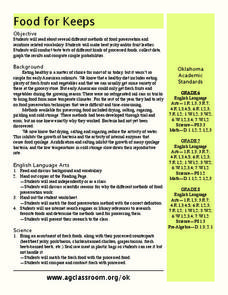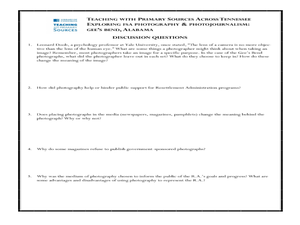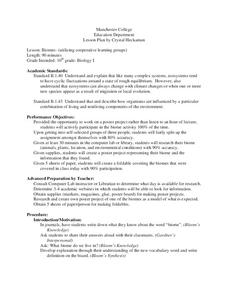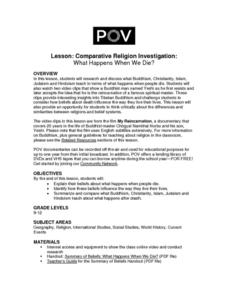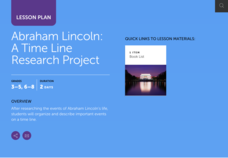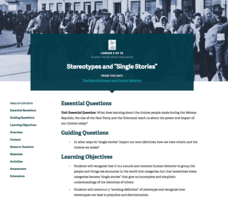Curated OER
Big Cats
Young scholars study what a niche is and its role in a community. In this cats lesson students research the Internet for information on big cat species.
Curated OER
The American Prairie
Students design an animal. In this prairie lesson, students learn about physical and behavioral adaptation, locate the Great Plains on a map, and design an animal that would be perfectly adapted for life on the prairie. ...
Curated OER
Food For Keeps
Middle schoolers explore food. In this processed and fresh foods lesson, students discover how some foods are processed and how they differ from fresh food. The complete group activities and an individual reading assignment. This lesson...
Curated OER
Paws in Jobland: Aspects of Working Life
Students discover concepts related to working conditions and practices. In this career lesson plan, students research information pertaining to specific jobs and then present it to their peers.
Curated OER
Ancient Egypt Alphabet Book
Students research Ancient Egypt using a specific letter of the alphabet as a guide. In this Ancient Egypt lesson, students independently research their assigned topic using ProQuest or other research software. Once students have...
Curated OER
Introducing Literature Circle Roles to Students
Students read a narrative selection and select a literature circle role. In this reading comprehension lesson, students work in groups to identify vocabulary, make text connections, or other reading comprehension strategies. Students...
Curated OER
Create a New Animal
Students understand what physical adaptations are and how they help an animal to survive. In this adaptations lesson, students research four animals and then make an original animal that has adaptations to make them survive.
Curated OER
A More Perfect Union: Women's Suffrage and the Constitution
Students reflect on the pros and cons of Women's Suffrage and it was viewed during the late 1800's. In this history lesson, students will analyze documents on women's suffrage so that they can compare and contrast the rights of...
Curated OER
Teaching with Primary Sources Across Tennessee
Students examine Gee's Bend Alabama. In this resettlement lesson plan, students view a series of photographs taken of Gee's Bend Alabama. Students will write a series of newspaper articles based on the images, that exemplify the...
Curated OER
Biomes
Tenth graders research locations of biomes and their barriers. In this biomes lesson, 10th graders examine location, environmental conditions, and species of plants and animals that live in the biome. Students take notes and create a...
Curated OER
Does Negative Space Have A Shape?
Students observe negative space in drawing. In this negative space lesson, students discover that sketches include negative space or background. Students produce a drawing while paying attention to the negative space.
Curated OER
Draw A Face
Students discover how to sketch a face. In this sketching lesson, students explore the steps to construct a facial drawing. Spacing and symmetry of facial features are explored.
Curated OER
The Basic Shapes of Everything
Students explore basic shapes in art. In this sketching instructional activity, students discover that art is created from basic shapes. Students determine the basic shapes in a picture and recreate the image.
Curated OER
Straberry Girl: Florida's Location and Shape
Students explore geography by reading a story about Florida. In this Florida vegetation instructional activity, students read the book Strawberry Girl and identify the locations in Florida that are mentioned in the book. Students...
University of Pennsylvania
Decoding Propaganda: J’Accuse…! vs. J’Accuse…!
Reading snail mail is a great way to go back into history and to understand others' points of view. The resource, the second in a five-part unit, covers the Dreyfus Affair. Scholars, working in two different groups, read one letter and...
Curated OER
Deck the Halls with Literature Trees
Reinforce and assess reading comprehension by having your class make a literature tree! After reading a book, pupils make decorations to represent the book's themes, characters, and setting. Materials for decorating can be as diverse and...
American Documentary
Comparative Religion Investigation: What Happens When We Die?
How do different religions offer explanations for what happens when we die? Invite your learners to consider the variance and complexity of religious beliefs, and to research and compare/contrast the concept of death and afterlife...
Curated OER
The Monroe Doctrine: Whose Doctrine Was It?
Was James Monroe the sole contributor of the Monroe Doctrine? Young scholars study the doctrine and cite evidence to show contributions of John Quincy Adams and Thomas Jefferson in its formulation.
National Endowment for the Humanities
Chief Executives Compared: The Federalist Papers
Delve into the responsibilities of the president by looking at President Hamilton's opinion of the presidential office in his own words. The second in a three-part series, the resource also offers an interesting compare-and-contrast...
Facing History and Ourselves
Kristallnacht: Decision-Making in Times of Injustice
Have you ever been singled out in a crowd before? Pupils investigate and analyze the events of the Holocaust. They dive into the life of a middle school student, as well as the diary entries of those in Kristallnacht during World War...
Facing History and Ourselves
The Weimar Republic: Historical Context and Decision Making
Did you know that way before Hitler became a dictator, he actually spent nine months in a German jail? Provide the background for the escalating point before the Nazi party took over in World War II through the exercises in the resource....
Scholastic
Abraham Lincoln: A Time Line Research Project
Though Abraham Lincoln's life was tragically cut short, it was filled with accomplishments and inspiring moments that continue to influence American democracy. Explore the ways the 16th president of the United States made his way from a...
Facing History and Ourselves
Stereotypes and “Single Stories”
Help bring subconscious stereotypes to the surface to stop it in its tracks. Pupils first read an excerpt describing the experience of prejudice and analyze how this process connects to World War II. Then, they write a creative story...
Facing History and Ourselves
How Should We Remember?
We must remember the past in order to avoid its mistakes. Young historians analyze the importance of historical remembrance using primary and secondary documents, as well as video clips. They then study the creation of a World War...
Other popular searches
- Fifth Grade Library Lessons
- Library Lessons K 2
- Elementary Library Lessons
- Library Lessons & November
- Kindergarten Library Lessons
- Library Lessons Grade
- Library Lessons for Preps
- Halloween Lessons Library
- Teks Library Lessons
- Library Lessons on Blogs
- Third Grade Library Lessons
- Library Lessons Grade 7




